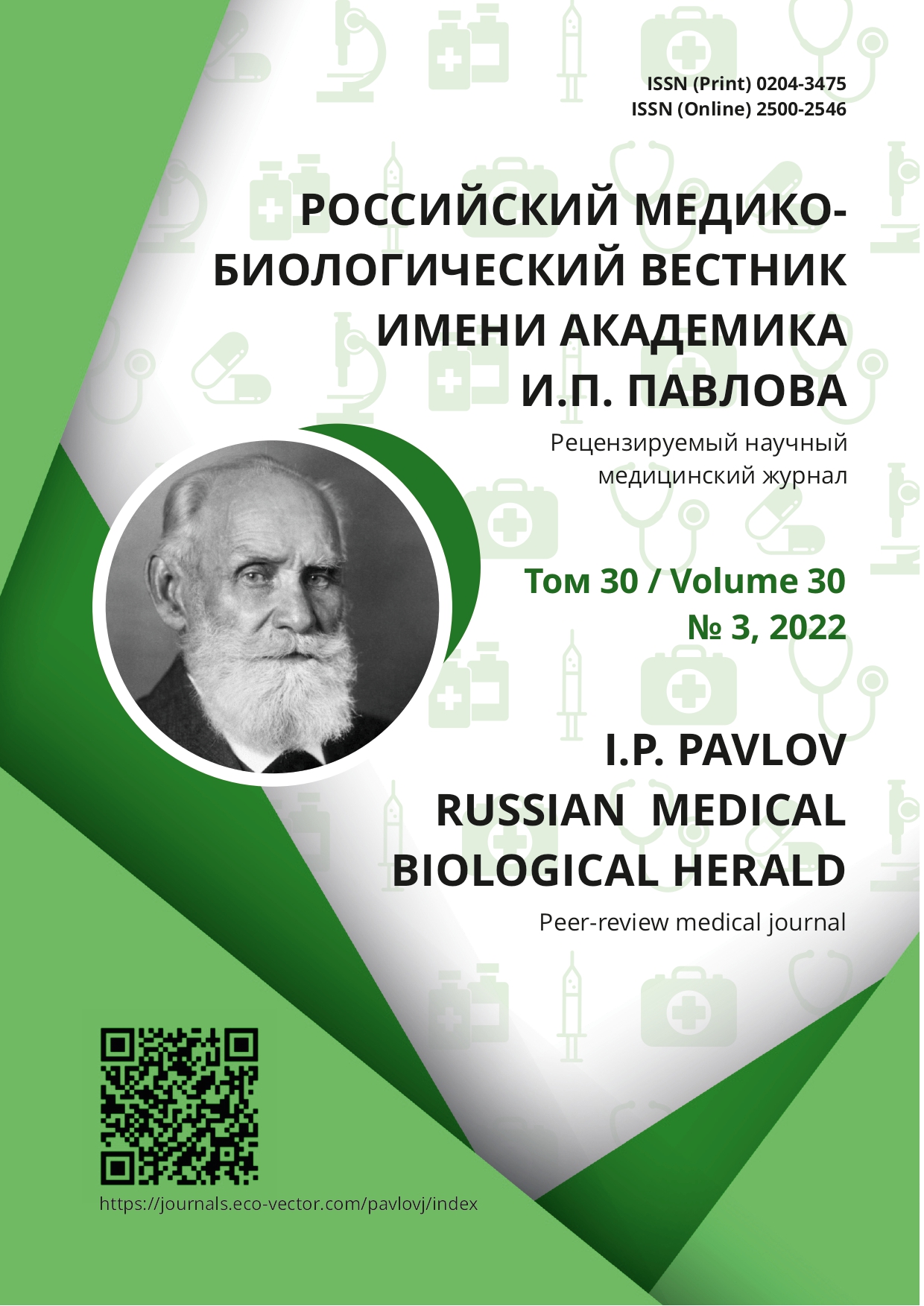Clinical and Pathomorphological Analysis of Mechanisms of Progression of Dupuytren’s Contracture
- Authors: Shchudlo N.A.1, Stupina T.A.1, Varsegova T.N.1, Ostanina D.A.1
-
Affiliations:
- Ilizarov’ National Medical Research Centre for Traumatology and Orthopedics
- Issue: Vol 30, No 3 (2022)
- Pages: 345-356
- Section: Original study
- Submitted: 10.03.2022
- Accepted: 12.07.2022
- Published: 07.10.2022
- URL: https://journals.eco-vector.com/pavlovj/article/view/104653
- DOI: https://doi.org/10.17816/PAVLOVJ104653
- ID: 104653
Cite item
Abstract
INTRODUCTION: The factors and mechanisms of progression and recurrence of the palmar fascial fibromatosis with formation of severe Dupuytren’s contracture, remain insufficiently studied.
AIM: To identify probable mechanisms of progression of the palmar fascial fibromatosis based on the comparative analysis of clinical and morphological characteristics of patients with Dupuytren’s contracture of different extent of severity.
MATERIALS AND METHODS: Objects: medical histories and histological preparations of surgical material of patients with I–II (group 1, n = 121) and III–IV (group 2, n = 135) degree Dupuytren’s contracture. Methods: clinical, histological, statistical.
RESULTS: Clinical markers of hereditary predisposition to Dupuytren’s disease (the percentage of patients under 50 at the time of onset of the disease and the frequency of involvement of both hands) were comparable in the study groups. The incidence of diseases of the circulatory system was reliably higher in group 2: 57.0% against 41.3% (p < 0.01). A prolonged course of the disease (> 8 years) was identified only in half of the patients of group 2. The median of the content of hyperplastic connective tissue in the palmar aponeurosis in patients of groups 1 and 2 was 22.9% and 11.3%, respectively (p < 0.001), interquartile range 0%–67.8% and 0%–56.7%, respectively. In the capillary network and in the intima of larger vessels, CD34-positive endothelium was identified in patients of both groups. Around the blood vessels supplying fibromatous nodules and cords, cells expressing CD34 were found. Thickness of adventitia and Kernogan index in the arteries perforating the palmar aponeurosis, were higher in group 2.
CONCLUSION: A higher frequency of comorbid diseases of the circulatory system, more evident thickening of adventitia of arteries perforating the palmar aponeurosis, and reduction of their throughput capacity in patients with severe Dupuytren’s contractures indicate the significance of systemic and regional vasogenic mechanisms of progression of the palmar fascial fibromatosis. The content of hyperplastic connective tissue (histological predictor of recurrence) varies individually with each degree of contracture.
Full Text
About the authors
Natal’ya A. Shchudlo
Ilizarov’ National Medical Research Centre for Traumatology and Orthopedics
Email: nshchudlo@mail.ru
ORCID iD: 0000-0001-9914-8563
SPIN-code: 3795-4250
ResearcherId: H-5588-2018
MD, Dr. Sci. (Med.)
Russian Federation, KurganTat’yana A. Stupina
Ilizarov’ National Medical Research Centre for Traumatology and Orthopedics
Email: stupinasta@mail.ru
ORCID iD: 0000-0003-3434-0372
SPIN-code: 7598-4540
ResearcherId: O-4352-2018
Dr. Sci. (Biol.)
Russian Federation, KurganTat’yana N. Varsegova
Ilizarov’ National Medical Research Centre for Traumatology and Orthopedics
Author for correspondence.
Email: varstn@mail.ru
ORCID iD: 0000-0001-5430-2045
SPIN-code: 1974-8274
ResearcherId: O-6886-2018
Cand. Sci (Biol.)
Russian Federation, KurganDar’ya A. Ostanina
Ilizarov’ National Medical Research Centre for Traumatology and Orthopedics
Email: ostaninadar@yandex.ru
ORCID iD: 0000-0002-4399-2973
SPIN-code: 9104-7840
ResearcherId: ААЕ-9123-2022
аспирант
Russian Federation, KurganReferences
- Auld T, Werntz JR. Dupuytren's disease: How to recognize its early signs. The Journal of Family Practice. 2017;66(3):E5-10.
- Eaton C. Evidence–based medicine: Dupuytren contracture. Plastic and Reconstructive Surgery. 2014;133(5):1241–51. doi: 10.1097/PRS.0000000000000089
- Altziebler J, Hubmer M, Parvizi D, et al. Dupuytren’s contracture: the status and impact of collagenase Clostridium histolyticum treatment in Austria. Safety in Health. 2017;3:12. doi: 10.1186/s40886-017-0063-8
- Reilly RM, Stern PJ, Goldfarb CA. A retrospective review of the management of Dupuytren’s nodules. Journal of Hand Surgery. 2005;30(5):1014–8. doi: 10.1016/j.jhsa.2005.03.005
- Dutta A, Jayasinghe G, Deore S, et al. Dupuytren's Contracture ― Current Concepts. Journal of Clinical Orthopedics and Trauma. 2020; 11(4):590–6. doi: 10.1016/j.jcot.2020.03.026
- Hever P, Smith OJ, Nikkhah D. Dupuytren's Fasciectomy: Surgical Pearls in Planning and Dissection. Plastic and Reconstructive Surgery. Global Open. 2020;8(7):e2832. doi: 10.1097/GOX.0000000000002832
- Miranda BH, Elliott C, Kearsey CC, et al. 3-Dimensional fasciectomy: A highly efficacious common ground approach to Dupuytren's surgery. Archives of Plastic Surgery. 2018;45(6):557–63. doi: 10.5999/aps.2016.02131
- Balaguer T, David S, Ihrai T, et al. Histological staging and Dupuytren's disease recurrence or extension after surgical treatment: a retrospective study of 124 patients. The Journal of Hand Surgery. European Volume. 2009;34(4):493–6. doi: 10.1177/1753193409103729
- Dumitrescu–Ionescu D. A New Therapeutic Approach to Dupuytren’s Contracture/Disease (DD). Advances in Plastic & Reconstructive Surgery. 2017;1(4):118–25. doi: 10.13140/RG.2.2.22150.06721
- Tubiana R. Dupuytren’s disease of the radial side of the hand. Hand Clinics. 1999;15(1):149–59.
- Warren RF. The pathology of Dupuytren’s contracture. British Journal of Plastic Surgery. 1953;6(3):224–30. doi: 10.1016/s0007-1226(53)80030-5
- Shchudlo NA, Kostin VV. Pathogenesis of neuropathy in Dupuytren's contracture. Genij Ortopedii. 2019;25(1):58–64. (In Russ). doi: 10.18019/1028-4427-2019-25-1-58-64
- Morelli I, Fraschini G, Banfi AE. Dupuytren’s Disease: Predicting factors and associated conditions. A single center questionnaire–based case–control study. The Archives of Bone and Joint Surgery. 2017;5(6):384–93.
- Balık MS, Bedir R. Palmar Fibromatosis: An Analysis of 25 Cases. European Archives of Medical Research. 2019;35(1):43–8. doi: 10.4274/eamr.galenos.2018.09719
- Rombouts JJ, Nöel H, Legrain Y, et al. Prediction of recurrence in the treatment of Dupuytrena’s disease: evaluation of a histologic classification. The Journal of Hand Surgery. 1989;14(4):644–52. doi: 10.1016/0363-5023(89)90183-4
- Tan K, Withers AHJ, Tan ST, et al. The Role of Stem Cells in Dupuytren's Disease: A Review. Plastic and Reconstructive Surgery. Global Open. 2018;6(5):e1777. doi: 10.1097/GOX.0000000000001777
- On N, Koh SP, Brasch HD, et al. Embryonic Stem Cell-Like Population in Dupuytren's Disease Expresses Components of the Renin-Angiotensin System. Plastic and Reconstructive Surgery. Global Open. 2017;5(7):e1422. doi: 10.1097/GOX.0000000000001422
- Mavlikeyev MO. Vliyaniye autotransplantatsii stvolovykh kletok perifericheskoy krovi na plotnost’ kapillyarnoy seti v skeletnoy myshtse u bol’nykh khronicheskimi obliteriruyushchimi zabolevaniyami arteriy nizhnikh konechnostey. Sovremennyye Naukoyemkiye Tekhnologii. 2009;(11):143–9. (In Russ).
- Shchudlo NA, Varsegova TN, Stupina TA, et al. Types and stages of vascular remodeling in Dupuytren's contracture (analysis of 506 arteries in the surgical material of 111 patients). Genij Ortopedii. 2020;26(2):179–84. (In Russ). doi: 10.18019/1028-4427-2020-26-2-179-184
- Stenmark KR, Yeager ME, El Kasmi KC, et al. The adventitia: essential regulator of vascular wall structure and function. Annual Review of Physiology. 2013;75:23–47. doi: 10.1146/annurev-physiol-030212-183802
Supplementary files















